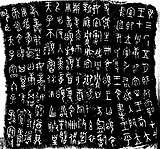Writing in a variety of Chinese scripts on ritual bronzes
Chinese bronze inscriptions, also referred to as bronze script or bronzeware script, comprise Chinese writing made in several styles on ritual bronzes mainly during the Late Shang dynasty (c. 1250 – c. 1046 BC) and Western Zhou dynasty (c. 1046 – 771 BC). Types of bronzes include zhong bells and ding tripodal cauldrons. Early inscriptions were almost always made with a stylus into a clay mold, from which the bronze itself was then cast. Additional inscriptions were often later engraved onto bronzes after casting.[1] The bronze inscriptions are one of the earliest scripts in the Chinese family of scripts, preceded by the oracle bone script.


